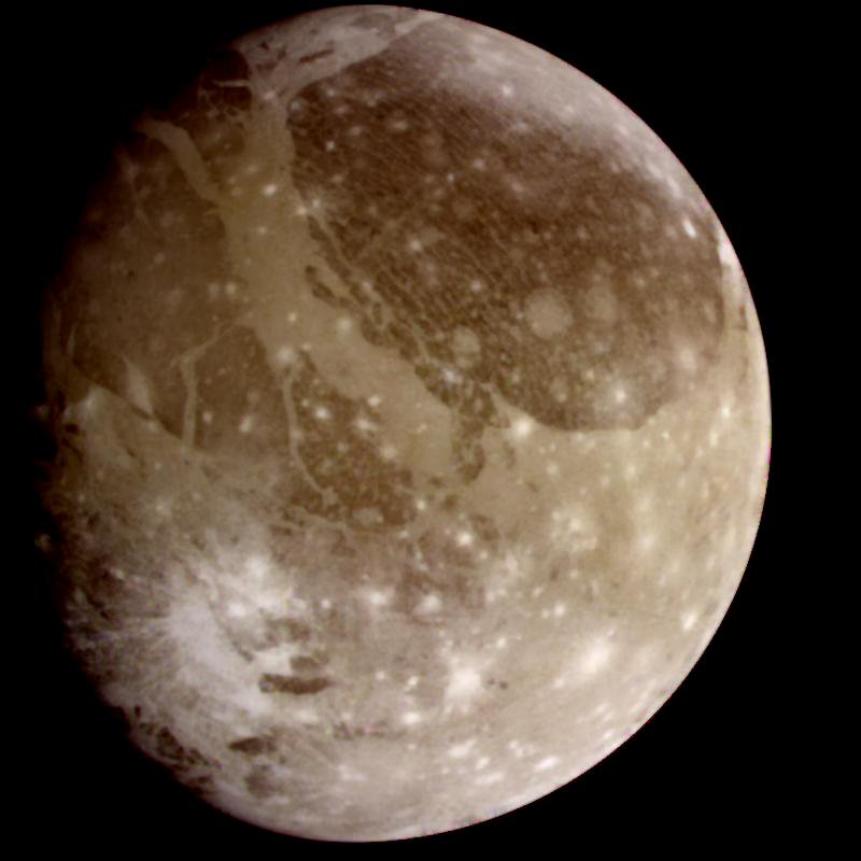
NASA/JPL-Caltech/SwRI
All Hail Ganymede, King of the Moons

NASA’s Juno probe, the supremely awesome Jupiter orbiter, recently captured some stunning images of Ganymede, the largest moon of Jupiter, during the orbiter’s 34th trip around the giant.
Ganymede is big. Really big. With a diameter of over 3,000 miles, it’s the largest moon and the 9th largest object in the solar system (it’s wider even than the planet Mercury but less than half as massive). To give you some context, it’s wider than the continental United States.
Its atmosphere isn’t much to write home about – just a thin smattering of various combinations of oxygen. It’s the only moon in the solar system with its own magnetic field that's powered by its liquid iron core.
Wait…liquid iron core? An object like Ganymede is far too small to maintain the heat from its formation. You need Earth-scale sizes for that. What’s keeping Ganymede so warm?

USGS Astrogeology Science Center/Wheaton/NASA/JPL-Caltech
Left to right: The mosaic and geologic maps of Jupiter’s moon Ganymede were assembled incorporating the best available imagery from NASA’s Voyager 1 and 2 spacecraft and NASA’s Galileo spacecraft.
It’s the moon’s motion around Jupiter that keeps it toasty. Its orbit is elliptical – sometimes closer, sometimes farther from the giant planet. As it orbits, the gravity of Jupiter stretches and squeezes the moon like a giant piece of putty. This friction warms the interior enough to melt iron.
Beneath its icy surface astronomers believe Ganymede hosts a globe-spanning liquid water ocean, kept warm by that same funky orbital motion. That’s more liquid water than the Earth has.
Beneath that giant ocean sits a layer of Ice-VI, which is a form of water ice that can only exist under extreme pressures. Below that is a rocky mantle, surrounding the iron core.

NASA/JPL
Natural color view of Ganymede from the Galileo spacecraft during its first encounter with the satellite. North is to the top of the picture and the sun illuminates the surface from the right. The dark areas are the older, more heavily cratered regions and the light areas are younger, tectonically deformed regions. The brownish-gray color is due to mixtures of rocky materials and ice. Bright spots are geologically recent impact craters and their ejecta.
The surface itself is mostly water ice. Some of that ice is much darker than the rest, which astronomers believe means that its laid there undisturbed for billions of years, accumulating interplanetary dust all that time. There are also massive craters on the darker parts, like Tros, which was imaged as part of Juno’s flyby.
The lighter parts of Ganymede are much younger, featuring smoother terrain. We’re not exactly sure what keeps those parts of Ganymede so much, but we suspect it’s a process similar to plate tectonics on Earth, just with ice instead of rock.
It’s been over 20 years since we’ve had a close-up view of Ganymede. The last spacecraft to visit the Jovian system was NASA’s Galileo probe in 2000. This time, June was able to fly just 645 miles above the surface of the enigmatic moon, gliding by at 41,600 miles per hour.

NASA
Space Shuttle Atlantis deployed the Galileo spacecraft six hours, 30 minutes into the flight on Oct. 18, 1989. In this image, Galileo, mounted atop the inertial upper stage, is tilted to a 58-degree deployment position in Atlantis's payload bay with the Earth's limb appearing in the background.
And that about sums up humanity’s entire knowledge about Ganymede. It’s a relatively unexplored place in our solar system, which is why it’s full of mysteries. How did its surface develop all these interesting features? Does some form of exotic life swim around in its world-girdling ocean? What does the interior of Ganymede teach us about the formation of the solar system?
NASA is sending another mission to Jupiter later this decade. But that mission, the Europa Clipper, will be focused on Ganymede’s sibling moon. It will be up to the European Space Agency and their Jupiter Icy Moons Explorer (codenamed JUICE) to help us reveal more of Ganymede’s secrets. Then perhaps we’ll have more answers than questions when it comes to the largest moon in the solar system.
Dive Deeper into the Cosmos
Journey Through the Cosmos in an All-New Season of How the Universe Works
The new season premieres March 24 on Science Channel and streams on discovery+.























